In this article, we will consider the possibilities and methods of powering digital devices assembled by our own hands, in particular on. It's no secret that the pledge successful work any device is powered correctly. Of course, the power supply must be capable of delivering the power required to power the device, have a large electrolytic capacitor at the output, to smooth out ripples, and it is desirable to be stabilized.
I will especially emphasize the latter, various unstabilized power supplies such as chargers from cell phones, routers and similar equipment are not suitable for powering microcontrollers and other digital devices directly. Since the voltage at the output of such power supplies changes, depending on the power of the connected load. The exception is stabilized chargers with a USB output that give out 5 volts, like charging from smartphones.

Many beginners to study electronics, and just those who are simply interested, I think were shocked by the fact: on a power adapter, for example, from a set-top box Dandy, and any other similar unstabilized can be written 9 volts DC (or D.C.), and when measuring with a multimeter with probes connected to the contacts of the power supply plug on the multimeter screen, all 14, or even 16. Such a power supply can be used, if desired, to power digital devices, but a stabilizer on a 7805 microcircuit or KREN5 must be assembled. Below in the photo is the L7805CV microcircuit in the TO-220 package.

Such a stabilizer has an easy connection scheme, from the body kit of the microcircuit, that is, of those parts that are necessary for its operation, we need only 2 ceramic capacitors of 0.33 microfarads and 0.1 microfarads. The connection diagram is known to many and is taken from Datasheet on a microcircuit:

Accordingly, we apply voltage to the input of such a stabilizer, or connect it to the plus of the power supply. And we connect the minus to the minus of the microcircuit, and feed it directly to the output.
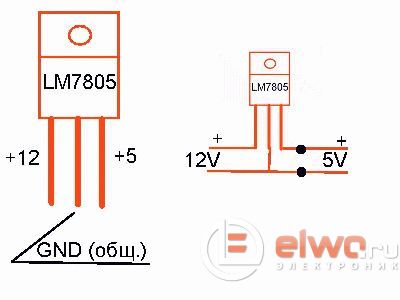
And we get at the output the stable 5 volts we need, to which, if desired, if you make the appropriate connector, you can connect the USB cable and charge the phone, mp3 player or any other device with the ability to charge from the USB port.
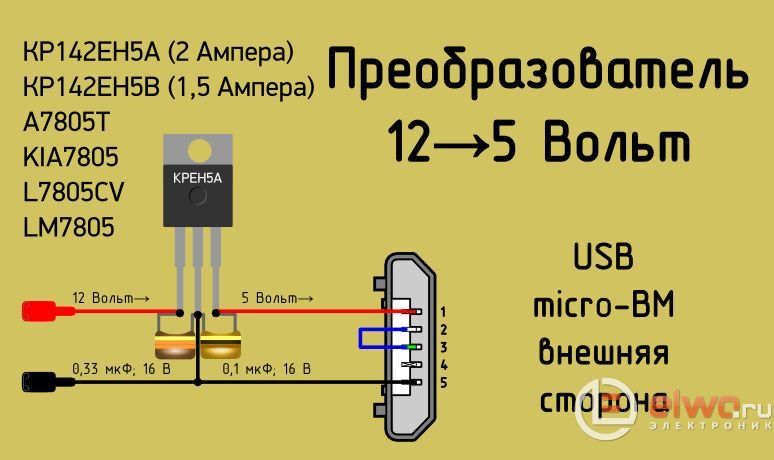
Stabilizer reduction from 12 to 5 volts - diagram
A car charger with a USB output has long been known to everyone. Inside, it is arranged according to the same principle, that is, a stabilizer, 2 capacitors and 2 connectors.

As an example for those who want to assemble a similar charger with their own hands or fix an existing one, I will give its circuit, supplemented by a power-on indication on the LED:

The pinout of the 7805 microcircuit in the TO-220 package is shown in the following figures. When assembling, it should be remembered that the pinout of microcircuits in different cases is different:

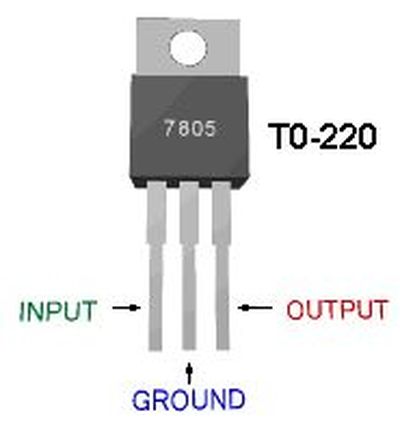
When buying a microcircuit in a radio store, you should ask for a stabilizer, like the L7805CV in the TO-220 case. This microcircuit can work without a heatsink at a current of up to 1 ampere. If work is required at high currents, the microcircuit must be installed on a radiator.

Of course, this microcircuit also exists in other cases, for example TO-92, familiar to everyone from low-power transistors. This regulator operates at currents up to 100 milliamperes. The minimum input voltage at which the regulator starts to work is 6.7 volts, standard from 7 volts. A photo of the microcircuit in the TO-92 package is shown below:

The pinout of the microcircuit in the TO-92 package, as already written above, differs from the pinout of the microcircuit in the TO-220 package. We can see it in the following figure, as it becomes clear from it that the legs are mirrored in relation to TO-220:

Of course, stabilizers are produced for different voltages, for example, 12 volts, 3.3 volts and others. The main thing is not to forget that the input voltage should be at least 1.7 - 3 volts more than the output.

Microcircuit 7833 - circuit
The following figure shows the pinout of the 7833 stabilizer in the TO-92 housing. Such stabilizers are used to power displays, memory cards and other peripherals in devices on microcontrollers that require a lower voltage supply than 5 volts, the main power of the microcontroller.

Stabilizer for MK power supply
I use a stabilizer in the case, as in the photo above, to power devices assembled and debugged on a prototype board on microcontrollers. Power is supplied from an unregulated adapter through the socket on the device board. His circuit diagram shown in the figure below:
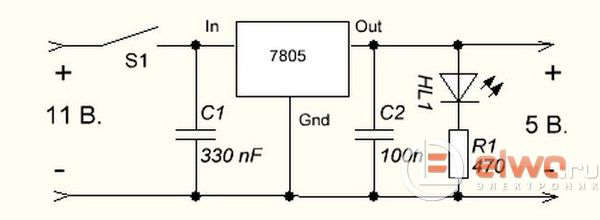
When connecting a microcircuit, you must strictly comply with the pinout. If the legs are confused, even one turn on is enough to disable the stabilizer, so you need to be careful when turning it on. The author of the material is AKV.
The popular 78xx series positive voltage compensation stabilizers were developed in 1976 by Texas Instruments. Later, their modifications appeared (Table 6.3) and similar developments of other companies. Output voltages are standardized according to the series: 1.5; 1.8; 2.5; 2.7; 2.8; 3.0; 3.3; 4; 5; 6; eight; 9; 12; 15; eighteen; 24 V. Manufacturers are distinguished by the first letters in the name, for example, L7812 (STMicroelectronics), КА7805 (Samsung), NJM78L03 (NJRCorporation), LM7805 (Fairchild), UTC7805 (Unisonic Technologies). In the CIS countries, these stabilizers are known from the KR142ENxx series microcircuits.
An important nuance. The permissible voltage drop between the input and output of the stabilizer (£ / In-out) depends on the load current. So, for example, for microcircuits of the "7805" series, it is 1 V at a current of 20 mA and 2 V at a current of 1 A. In brief reference data, only the last parameter (2 V / 1 A) is usually indicated, and full load characteristics are given only datasheet charts. Therefore, by carefully studying them, you can avoid unnecessary reinsurance.
All modern integrated stabilizers are protected against short circuit in the load, from the temperature overheating of the crystal and from the exit of the operating point from the zone safe work.
Except stabilizers fixed voltage there are integral adjustable stabilizers. The first samples were developed by Robert Dobkin in 1977 at National Semiconductor. Typical representatives of this direction are microcircuits of the "317" series, the output voltage of which is determined by a divider across two resistors.
In Fig. 6.6, a ... p show circuits of adjustable and unregulated integral positive voltage stabilizers.

Rice. 6.6. Positive voltage compensation integral stabilizer circuits (beginning):
a) typical scheme switching on the integrated stabilizer DAL A series of microcircuits "78Lxx" is ideal for simple amateur designs containing MK and having a current consumption of up to 100 mA. The built-in short-circuit protection in DA1 limits the output current to 0.1 ... 0.2 A, which in many cases saves the MC in case of an emergency. The input voltage is filtered by elements L1, C1, C2, and the inductor may be absent. Capacitors C1, C4 are installed near (0 ... 70 mm) from the terminals of the DA1 stabilizer to prevent self-excitation of the latter. The capacitance of the capacitor C2 must be several times larger than the capacitance of the capacitor C3, otherwise a protective diode VD1 must be installed (shown by a dotted line). The main thing is that when the power is turned off, the output voltage of +5 V decreases in time faster than the input voltage +6.5 ... + 15 V (for this, the capacity of the capacitor C2 is increased), otherwise the DA1 microcircuit may fail. If you are not sure, then a similar diode is recommended to be installed in other similar circuits;
b) the DA1 stabilizer (Maxim / Dallas) does not belong to the 78xx series. It differs in name and functionality. In particular, the DA1 microcircuit has an input for turning off the stabilizer (pin 4) and an input for smooth voltage regulation (pin 5). Microcircuits MAX603 and MAX604 are interchangeable and provide +5 and +3.3 V at the output, respectively;
c) LDO-stabilizer on the DA1 microcircuit with a maximum load current of 1 A (analogue of K1184EN1). In the LM2940 family, there are microcircuits with an output voltage of 5; eight; 9; 10; 12; 15 V, and in the LP2950 family - with a voltage of 3.0; 3.3; 5V;
d) UltraLDO-stabilizer on a DA1 microcircuit in an SMD package. Voltage UВХ-out is not more than 0.12 V at a load current of 50 mA and not more than 7 mV at a load current of 1 mA. There are modifications of this stabilizer with an output voltage according to the series: 1.5; 1.8; 2.5; 2.85; 3.0; 3.2; 3.3; 3.6; 3.8; 4.0; 4.7; 4.85; 5.0V;
![]()

e) an adjustable voltage regulator based on a DAI microcircuit of the "317" series.
f) voltage +13 V is obtained by adding two voltages of stabilizers DAI and DA2
g) HL1 indicator is on green at normal voltage of the battery / accumulator GB1 within 6.8 ... 9 V. Below 6.8 V, its glow stops, which is a signal to replace the battery or recharge the battery;
h) the standard method of increasing the output voltage of the DA1 stabilizer by 0.1 ... 0.3 V. This may be required if the parameters of the DA I microcircuit are substandard or to test the operation of the MC with increased power supply. Resistor R1 within small limits regulates the output voltage on the linear section of the I - V characteristic of the diode VD1 (current 5 ... 10 mA). The RI resistor is not necessary if the DAI microcircuit of the "78LC05", "78-L05" series is replaced with a similar one from the "7805" series, which has a current consumption through the GND pin in the range of 3 ... 8 mA;
i) DAI voltage stabilizer is supplemented with a current amplifier on the DA2 sound microcircuit, which is used as a voltage follower with a load of up to 3 A.

Rice. 6.6. Positive voltage compensation integral stabilizer circuits (continued):
j) the high input voltage of 60 V is first reduced to 23 V (DA1), and then to 5 V (DA2). The voltage difference between the input and output of the DAI microcircuit should not exceed 40 V. At a high load current, it may be necessary to install DAI, DA2 microcircuits on the radiators;
l) resistor RI smoothly adjusts the voltage in the upper, more powerful channel. If the middle terminal of the resistor RI, as a result of the rotation of its engine, is electrically connected to the common wire, then the two channels will have identical voltages of +5 V. Stabilizers DAI, DA2 can have either the same or different output voltages;
m) the power supply unit with the conditional name "Step" consists of series-connected voltage stabilizers DA1 ... DA3. The load current, summed up over three circuits + 12, +9 and +5 V, should not exceed the maximum permissible current for the DA1 microcircuit
m) obtaining two identical voltages from one common source +7 ... + 15 V. This is useful, for example, for decoupling analog and digital circuits of the MK or for a separate power supply of a highly sensitive input amplifier;
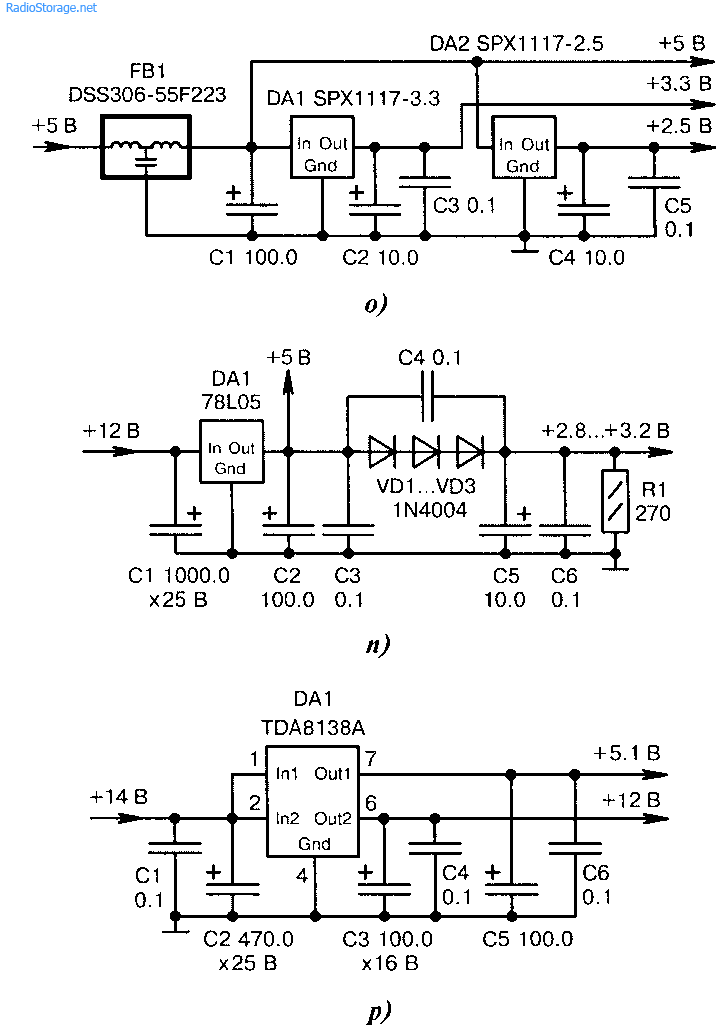
Rice. 6.6. Positive voltage compensation integral stabilizer circuits (end):
o) obtaining three different stabilized voltages for powering the processor core, as well as internal and external peripherals in new modern MCUs. The FBI interference suppression filter (Murata Manufacturing) has a small size. It can be replaced with a single-link discrete LC filter;
n) obtaining a well-stabilized voltage of +5 V and a "quasi-stabilized" voltage of +2.8 ... + 3.2 V. VD1 ... VD3 diodes reduce the output voltage, but it will depend on the current and temperature flowing through them environment... There can be not three diodes, but two, both conventional and Schottky diodes. Resistor R1 serves for the initial load of the flux in order to fix the operating point of the diodes on the steep vertical branch of the I - V characteristic, starting from 10 mA;
p) a two-channel voltage regulator DA1 (STMicroelectronics) provides power to two output paths +5.1 and +12 V. The load current in each channel can be 0.75 ... 1 A.
One of the important components of electronic equipment is a voltage stabilizer in the power supply. More recently, such units were built on zener diodes and transistors. The total number of stabilizer elements was quite large, especially if it was required to regulate the output voltage, protect against overload and output short circuit, and limit the output current at a given level. With the advent of specialized microcircuits, the situation has changed. Microcircuit voltage stabilizers are capable of operating in a wide range of output voltages and currents, often have a built-in protection system against overcurrent and overheating - as soon as the temperature of the microcircuit crystal exceeds the allowable value, the output current is limited. Currently, the range of domestic and foreign voltage stabilizers is so wide that it has become quite difficult to navigate in it. Placed below table. are designed to facilitate the preliminary selection of a microcircuit stabilizer for a particular electronic device. Table 13.4 presents a list of the most common three-terminal microcircuits of linear voltage stabilizers for a fixed output voltage and their main parameters on the domestic market. In fig. 13.4 is simplified appearance devices, and also indicated their pinout. The table includes only stabilizers with an output voltage ranging from 5 to 27 V - the vast majority of cases from amateur radio practice fit into this interval. The design of foreign devices may differ from that shown. It should be borne in mind that information about the power dissipation during operation of a microcircuit with a heat sink is usually not indicated in the device passports, therefore the tables give some of its averaged values obtained from the graphs available in the documentation. Note also that microcircuits of the same series, but for different voltage values, may differ in terms of power dissipation. There is also another marking, for example, before the designation of the stabilizers of groups 78, 79, 78L, 79L, 78M, 79M, listed in the table, in fact, there may be one or two letters coding, as a rule, the manufacturer. Behind the designations indicated in the table, there may also be letters and numbers indicating certain design or operational features of the microcircuit. A typical circuit for switching on microcircuit stabilizers for a fixed output voltage is shown in Fig. 13.5 (a and b).
For all microcircuits of ceramic or oxide tantalum capacitors, the capacitance of the input capacitor C1 must be at least 2.2 μF, for aluminum oxide capacitors - at least 10 μF, and the output capacitor C2 - at least 1 and 10 μF, respectively. Some microcircuits allow less capacity, but the indicated values guarantee stable operation of any stabilizers. The capacitor of the smoothing filter can play the role of the input if it is located no further than 70 mm from the microcircuit case.
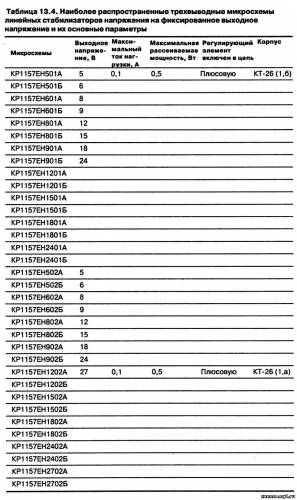
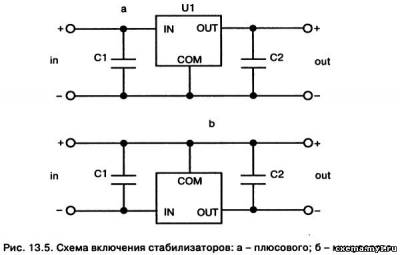
If a non-standard value of the stabilized output voltage or its smooth regulation is required, it is convenient to use specialized adjustable microcircuit stabilizers that support a voltage of 1.25 V between the output and the control pin. Their list is presented in table. 13.5.
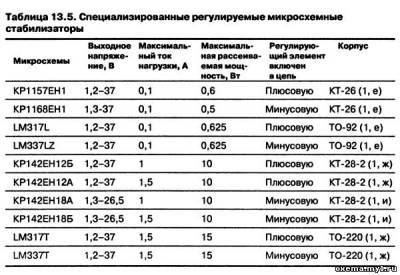
In fig. 13.6 shows a typical connection diagram for stabilizers with a regulating element in the positive lead. Resistors R1 and R2 form an external adjustable voltage divider, which is included in the output voltage level setting circuit. Please note that, unlike fixed output voltage regulators, variable capacitors do not operate without load. The minimum value of the output current of low-power adjustable stabilizers is 2.5-5 mA, powerful - 5-10 mA. In most cases of using stabilizers, the load is a resistive voltage divider Rl, R2 in Fig. 13.6. According to this scheme, stabilizers with a fixed output voltage can also be turned on. However, firstly, the current consumed by them is much higher than B-4 mA), and, secondly, it is less stable when the output current and input voltage change. For these reasons, the maximum possible stabilization factor of the device cannot be achieved. To reduce the level of ripple at the output, especially at a higher output voltage, it is recommended to include a smoothing capacitor C3 with a capacity of 10 μF or more. The requirements for capacitors C1 and C2 are the same as for the corresponding capacitors of fixed stabilizers. If the stabilizer operates at the maximum output voltage, then if the input circuit is accidentally closed or the power supply is disconnected, the microcircuit is under a large reverse voltage from the load side and may be damaged. To protect the microcircuit at the output in such situations, a protective diode VD1 is connected in parallel to it. Another protective diode VD2 protects the microcircuit from the side of the charged capacitor C3. The diode quickly discharges this capacitor in the event of an emergency short circuit of the output or input circuit of the stabilizer.
Integral stabilizers voltage from series 142 do not always have full type markings. In this case, there is a conventional designation code on the case, which allows you to determine the type of microcircuit.
Examples of decoding code marking on the case of microcircuits:

Stabilizer microcircuits with attachment KR instead of TO have the same parameters and differ only in the design of the case. When marking these microcircuits, a shortened designation is often used, for example, instead of KR142EN5A inflict KREN5A.
| Name microcircuits | U stab., V | I st max., A | R max., W | I cons., mA | Frame | Code on the case |
| (K) 142EN1A | 3 ... 12 ± 0.3 | 0,15 | 0,8 | 4 | DIP-16 | (C) 06 |
| (K) 142EN1B | 3 ... 12 ± 0.1 | (C) 07 | ||||
| K142EN1V | 3 ... 12 ± 0.5 | K27 | ||||
| K142EN1G | 3 ... 12 ± 0.5 | К28 | ||||
| K142EN2A | 3 ... 12 ± 0.3 | K08 | ||||
| K142EN2B | 3 ... 12 ± 0.1 | К09 | ||||
| 142ENZ | 3 ... 30 ± 0.05 | 1,0 | 6 | 10 | 10 | |
| K142ENZA | 3 ... 30 ± 0.05 | 1,0 | K10 | |||
| K142ENZB | 5 ... 30 ± 0.05 | 0,75 | К31 | |||
| 142EN4 | 1.2 ... 15 ± 0.1 | 0,3 | 11 | |||
| K142EN4A | 1.2 ... 15 ± 0.2 | 0,3 | K11 | |||
| K142EN4B | 3 ... 15 ± 0.4 | 0,3 | K32 | |||
| (K) 142EN5A | 5 ± 0.1 | 3,0 | 5 | 10 | (C) 12 | |
| (K) 142EN5B | 6 ± 0.12 | 3,0 | (C) 13 | |||
| (K) 142EN5V | 5 ± 0.18 | 2,0 | (C) 14 | |||
| (K) 142EN5G | 6 ± 0.21 | 2,0 | (C) 15 | |||
| 142EN6A | ± 15 ± 0.015 | 0,2 | 5 | 7,5 | 16 | |
| K142EN6A | ± 15 ± 0.3 | K16 | ||||
| 142EN6B | ± 15 ± 0.05 | 17 | ||||
| K142EN6B | ± 15 ± 0.3 | K17 | ||||
| 142EN6V | ± 15 ± 0.025 | 42 | ||||
| K142EN6V | ± 15 ± 0.5 | KZZ | ||||
| 142EN6G | ± 15 ± 0.075 | 0,15 | 5 | 7,5 | 43 | |
| K142EN6G | ± 15 ± 0.5 | K34 | ||||
| K142EN6D | ± 15 ± 1.0 | K48 | ||||
| K142EN6E | ± 15 ± 1.0 | К49 | ||||
| (K) 142EN8A | 9 ± 0.15 | 1,5 | 6 | 10 | (C) 18 | |
| (K) 142EN8B | 12 ± 0.27 | (C) 19 | ||||
| (K) 142EN8V | 15 ± 0.36 | (C) 20 | ||||
| K142EN8G | 9 ± 0.36 | 1,0 | 6 | 10 | K35 | |
| K142EN8D | 12 ± 0.48 | K36 | ||||
| K142EN8E | 15 ± 0.6 | K37 | ||||
| 142EN9A | 20 ± 0.2 | 1,5 | 6 | 10 | 21 | |
| 142EN9B | 24 ± 0.25 | 22 | ||||
| 142EN9V | 27 ± 0.35 | 23 | ||||
| K142EN9A | 20 ± 0.4 | 1,5 | 6 | 10 | K21 | |
| K142EN9B | 24 ± 0.48 | 1,5 | K22 | |||
| K142EN9V | 27 ± 0.54 | 1,5 | К23 | |||
| K142EN9G | 20 ± 0.6 | 1,0 | K38 | |||
| K142EN9D | 24 ± 0.72 | 1,0 | К39 | |||
| K142EN9E | 27 ± 0.81 | 1,0 | K40 | |||
| (K) 142EN10 | 3...30 | 1,0 | 2 | 7 | (C) 24 | |
| (K) 142EN11 | 1 2...37 | 1 5 | 4 | 7 | (C) 25 | |
| (K) 142EN12 | 1.2...37 | 1 5 | 1 | 5 | CT-28 | (C) 47 |
| KR142EN12A | 1,2...37 | 1,0 | 1 | |||
| KR142EN15A | ± 15 ± 0.5 | 0,1 | 0,8 | DIP-16 | ||
| KR142EN15B | ± 15 ± 0.5 | 0,2 | 0,8 | |||
| KR142EN18A | -1,2...26,5 | 1,0 | 1 | 5 | CT-28 | (LM337) |
| KR142EN18B | -1,2...26,5 | 1,5 | 1 | |||
| KM1114EU1A | - | - | - | - | - | К59 |
| KR1157EN502 | 5 | 0,1 | 0,5 | 5 | CT-26 | 78L05 |
| KR1157EN602 | 6 | 78L06 | ||||
| KR1157EN802 | 8 | 78L08 | ||||
| KR1157EN902 | 9 | 78L09 | ||||
| KR1157EN1202 | 12 | 78L12 | ||||
| KR1157EN1502 | 15 | 78L15 | ||||
| KR1157EN1802 | 18 | 78L18 | ||||
| KR1157EN2402 | 24 | 78L24 | ||||
| KR1157EN2702 | 27 | 78L27 | ||||
| KR1170ENZ | 3 | 0,1 | 0,5 | 1,5 | CT-26 | See fig. |
| KR1170EN4 | 4 | |||||
| KR1170EN5 | 5 | |||||
| KR1170EN6 | 6 | |||||
| KR1170EN8 | 8 | |||||
| KR1170EN9 | 9 | |||||
| KR1170EN12 | 12 | |||||
| KR1170EN15 | 15 | |||||
| KR1168EN5 | -5 | 0,1 | 0,5 | 5 | CT-26 | 79L05 |
| KR1168EN6 | -6 | 79L06 | ||||
| KR1168EN8 | -8 | 79L08 | ||||
| KR1168EN9 | -9 | 79L09 | ||||
| KR1168EN12 | -12 | 79L12 | ||||
| KR1168EN15 | -15 | 79L15 | ||||
| KR1168EN18 | -18 | 79L18 | ||||
| KR1168EN24 | -24 | 79L24 | ||||
| KR1168EN1 | -1,5...37 |
Today, transistor voltage stabilizers are rarely used to connect equipment to power. This is due to the wide popularity of the use of integrated stabilization devices.
Using microcircuits
Consider the properties of imported and domestic microcircuits, which act instead of voltage stabilizers. They have parameters according to the table.
Foreign stabilizers of the 78 ... series are used to equalize the positive voltage potential, and the 79 ... series - the negative voltage potential. Typical microcircuits with the designation L are low-power devices. They are made in small plastic cases TO 26. Stabilizers are more powerful made in a case of the TOT type, similar to the KT 805 transistors, and are mounted on heat sinks.
Wiring diagram of the microcircuit KR 142 EN5

Such a microcircuit serves to create a stable voltage of 5-6 V, with a current of 2-3 A. Electrode 2 of the microcircuit is connected to metal base crystal. The microcircuit is fixed directly on the body without insulating spacers. The value of the capacitance depends on the highest current flowing through the stabilizer and at the lowest load currents - the value of the capacitance must be increased - the capacitor at the input must be at least 1000 μF, and at the output at least 200 μF. The operating value of the voltage of the capacitors must be suitable for the rectifier with a reserve of 20%.
If a zener diode is connected to the microcircuit electrode circuit (2), the output voltage will increase to the value of the microcircuit voltage, and the voltage of the zener diode is added to this value.
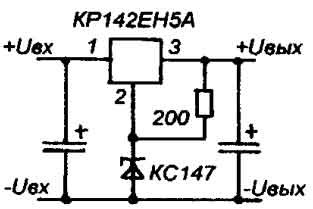
The 200 ohm resistance is designed to boost the current flowing through the zener diode. This will optimize voltage stability. In our case, the voltage will be 5 + 4.7 = 9.7 V. Weak zener diodes are connected in a similar way. To increase the current strength of the output of the stabilizer, transistors can be used.
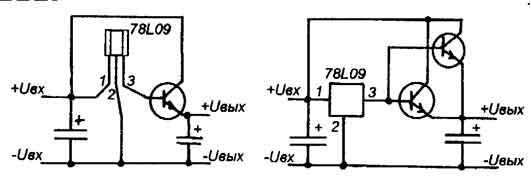
Type 79 microcircuits are used for leveling negative value and are connected in a chain in a similar way.

In the series of microcircuits there is a device with a variable output voltage - KR 142EN12 A:
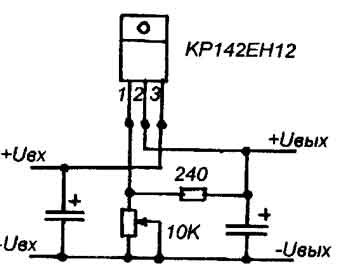
It should be noted that the pinout of the legs of 79 type microcircuits and KR 142 EN 12 differ from the typical one. This circuit, with an input voltage of 40 V, can provide a voltage of 1.2-37 V at a current strength of up to 1.5 A.
Replacing Zener Diodes
Voltage stabilizers have become one of the main components of electronic equipment. Until recently, such components included:
- Transistors of various series.
- Zener diodes.
- Transformers.
The total number of parts of the stabilizer was considerable, especially of the regulated device. With the advent of special microcircuits, everything changed. New ICs for stabilizers are manufactured for a wide voltage range, with built-in protection options.
The table contains a list of popular stabilizer microcircuits with designations.
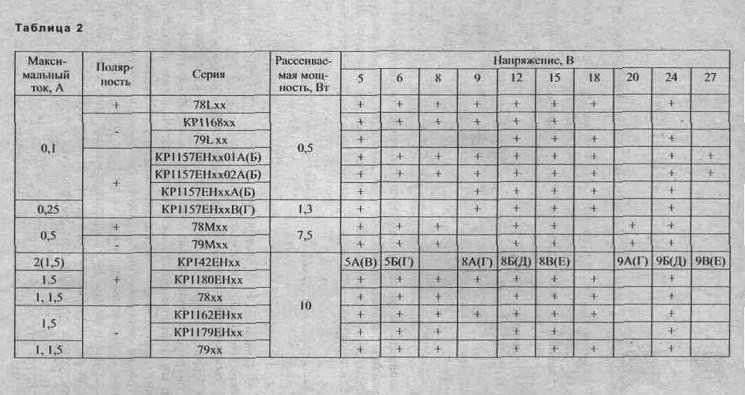
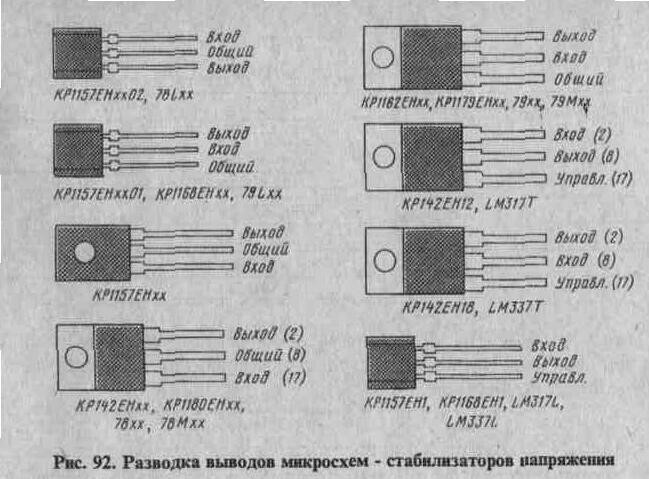
If you need a non-standard voltage with adjustment, then use 3-pin microcircuits with a voltage of 1.25 volts of the output and control output.
A typical scheme of operation of microcircuits for a certain voltage is shown in the figure. Capacity C1 is not less than 2.2 microfarads. 

Adjustable microcircuits, unlike fixed devices, cannot work without load.
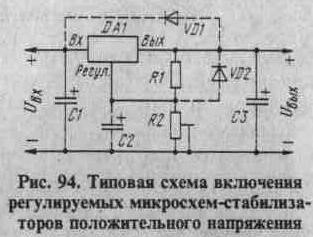
The smallest current of regulated microcircuits is 2.5-5 milliamperes for weak models, and up to 10 milliamperes for powerful ones. To reduce voltage ripple at high voltages, it is advisable to connect a 10 μF equalizing capacitor. The VD 1 diode serves as a protection for the microcircuit if there is no input voltage and supply of its output to the power supply. Diode VD 2 is designed to discharge the capacitance C2 when the input or output circuit is closed.
Disadvantages of microcircuits
The properties of microcircuits remain at the level of most use in the practice of radio amateurs. Of the shortcomings of microcircuits, it can be noted:
- The increased minimum voltage between the output and the input is 2-3 volts.
- Limitations on the largest parameters: input voltage, power dissipation, output current.
These disadvantages are not too noticeable and quickly pay off with simple use and low cost.
It's hard to find any electronic device not using a stabilized power supply. Mainly as a power source for the vast majority of various electronic devices designed to operate from 5 volts, the best option will be the use of a three-pin integral 78L05.
Description of the 78L05 stabilizer
This stabilizer is not expensive () and is easy to use, which makes it easier to design electronic circuits with a significant number of printed circuit boards, to which an unregulated constant voltage is supplied, and a separate stabilizer is mounted on each board.
Microcircuit - stabilizer 78L05 (7805) has thermal protection, as well as a built-in system protecting the stabilizer from overcurrent. However, for more reliable work it is desirable to use a diode to protect the stabilizer from a short circuit in the input circuit.
Technical parameters and pinout of the 78L05 stabilizer:
- Input voltage: 7 to 20 volts.
- Output voltage: 4.5 to 5.5 volts.
- Output current (maximum): 100mA.
- Consumption current (stabilizer): 5.5 mA.
- Permissible input-output voltage difference: 1.7 volts.
- Working temperature: -40 to +125 ° C.
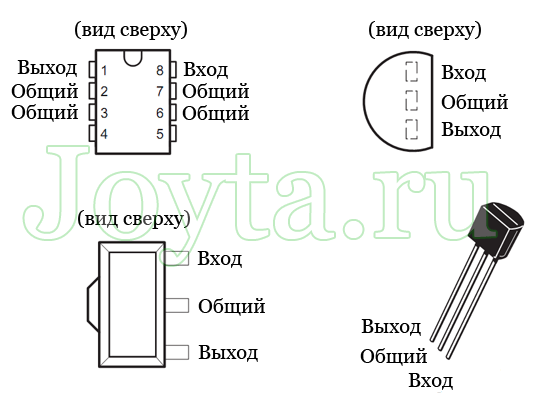
Analogs stabilizer 78L05 (7805)
There are two types of this microcircuit: powerful 7805 (load current up to 1A) and low-power 78L05 (load current up to 0.1A). Foreign analogue 7805 is ka7805. Domestic analogues are for 78L05 - KR1157EN5, and for 7805 - 142EN5
Connection diagram 78L05
A typical circuit for switching on the 78L05 stabilizer (according to datasheet) is easy and does not require a large number additional radioelements.

Capacitor C1 at the input is necessary to eliminate RF interference when the input voltage is applied. Capacitor C2 at the output of the stabilizer, as in any other power supply, ensures the stability of the power supply at abrupt change load current, and also reduces the degree of ripple.
When developing a power supply unit, it must be borne in mind that for the stable operation of the 78L05 stabilizer, the input voltage must be at least 7 and no more than 20 volts.
Below are a few examples of using the 78L05 Integrated Stabilizer.
78L05 laboratory power supply
This circuit is distinguished by its originality, due to the non-standard use of the microcircuit, the reference voltage of which is the 78L05 stabilizer. Since the maximum allowable input voltage for the 78L05 is 20 volts, a parametric stabilizer on the Zener diode VD1 and resistor R1 is added to the circuit to prevent the 78L05 from failing.

The TDA2030 microcircuit is connected as a non-inverting amplifier. With this connection, the gain is 1 + R4 / R3 (in this case 6). Thus, the voltage at the output of the power supply, when the resistance of the resistor R2 changes, will change from 0 to 30 volts (5 volts x 6). If you need to change the maximum output voltage, then this can be done by selecting the appropriate resistance of the resistor R3 or R4.
5 volt transformerless power supply
this one is characterized by increased stability, no heating of the elements and consists of available radio parts.

The structure of the power supply includes: a power-on indicator on the HL1 LED, instead of a conventional transformer - a quenching circuit on elements C1 and R2, a diode rectifier bridge VD1, capacitors to reduce ripple, a 9-volt VD2 Zener diode and an integrated voltage regulator 78L05 (DA1). The need for a zener diode is due to the fact that the voltage from the output diode bridge is approximately 100 volts and this could damage the 78L05 regulator. You can use any zener diode with a stabilization voltage of 8 ... 15 volts.
Attention!Since the circuit is not galvanically isolated from the mains, care should be taken when setting up and using the power supply.
Simple regulated power supply for 78L05

The adjustable voltage range in this circuit is from 5 to 20 volts. The output voltage is changed using variable resistor R2. The maximum load current is 1.5 amperes. The 78L05 stabilizer is best replaced with 7805 or its domestic analogue KR142EN5A. Transistor VT1 can be replaced with. It is advisable to place a powerful transistor VT2 on a radiator with an area of at least 150 sq. cm.
Universal charger circuit
This scheme charger quite simple and versatile. Charging allows you to charge all kinds of rechargeable batteries: lithium, nickel, as well as small lead-acid batteries used in uninterruptible power supplies.

It is known that when charging batteries, a stable charging current is important, which should be about 1/10 of the battery capacity. The constant charging current is ensured by the 78L05 (7805) stabilizer. The charger has 4 charging current ranges: 50, 100, 150 and 200 mA, which are determined by the resistances R4 ... R7, respectively. Based on the fact that the output of the stabilizer is 5 volts, then to obtain an admissible 50 mA, a 100 Ohm resistor is needed (5V / 0.05 A = 100), and so on for all ranges.
The circuit is also equipped with an indicator built on two transistors VT1, VT2 and an LED HL1. The LED goes out when the battery has finished charging.
Adjustable current source
Due to negative feedback, following through the load resistance, at input 2 (inverting) of the TDA2030 (DA2) microcircuit there is a voltage Uin. Under the influence of this voltage, a current flows through the load: Ih = Uin / R2. Based on this formula, the current flowing through the load does not depend on the resistance of this load.
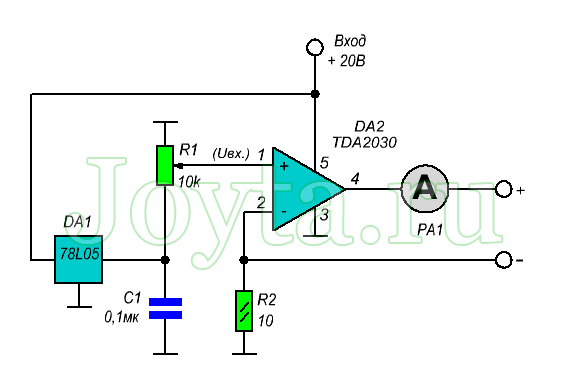
Thus, by changing the voltage supplied from the variable resistor R1 to input 1 of DA2 from 0 to 5 V, with a constant value of the resistor R2 (10 Ohm), you can change the current flowing through the load in the range from 0 to 0.5 A.
A similar scheme can be successfully used as a charger for charging all kinds of batteries. The charging current is constant during the entire charging process and does not depend on the level of discharge of the battery or on the variability of the supply network. The limiting charge current can be changed by decreasing or increasing the resistance of the resistor R2.
(161,0 Kb, downloaded: 3 935)




